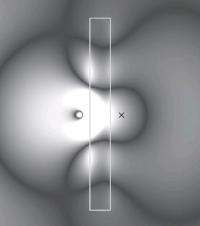January 28, 2010 report
Lens with 'Super Resolution' Could Improve Medical Imaging Applications

(PhysOrg.com) -- Some of the most recent research in imaging involves metamaterials, the synthetic materials that possess properties that are not observed in nature. Metamaterials are structured materials, in the sense that they are composed of cells. However, these finite cell sizes impose significant limitations on performance. Particularly in the area of imaging, cell size imposes limitations on resolution.
To overcome these limitations, Dr. Cesar Monzon, from Enig Associates, Inc., a government contractor in Bethesda, Maryland, has created a novel lens made of ferrite that is not composed of cells, and so does not have any structure. The lack of structure results in improved image quality, offering a resolution commensurate with the lens’ thickness, so that a very thin lens can achieve very high resolution. Since the ferrite lens does not have structure, it is not a metamaterial, although it is synthesized in the lab. Still, the lens’ engineered properties are similar to those obtainable with current metamaterials. Monzon predicts that the lens could be used to image inside non-magnetic objects, such as the human body.
“An important finding of this study is that a planar slab of some special ferrites of negative permeability offers a new avenue to realizing RF near-field imaging with super resolution,” Monzon told PhysOrg.com. “An important advantage of using these ferrite lenses is that the material does not have any structure, as it is not composed of cells. Not having any structure is very appealing as it results in improved image qualities, which for instance, in a medical application means the ability to probe significantly deeper.”
In order to analyze the way that microwaves propagate through the ferrite lens, Monzon performed a theoretical analysis and simulations in which he evaluated the imaging properties of ferrite slabs of varying thickness. The observed images showed that the resolving power of the ferrite lens is two to three times the lens thickness. Since the lens thickness can be made electrically very thin, this indicates that super resolution can be achieved in the near field, with capabilities into the gigahertz (GHz) range.
As Monzon explains, the kind of ferrite used in the new lens must exhibit a negative permeability in the GHz range, meaning that light waves passing through a flat lens will converge to an image. On the other hand, a conventional optical material has a positive refractive index, meaning that light waves passing through the lens will always diverge. That is why ordinary lenses need to be shaped in order to produce images.
Until now, negative permeability in ferrite has generally been seen as a flaw because most applications require good propagating characteristics of radio waves in the ferrite. Although negative permeability ferrites are not very well developed, there are plenty of them. The present lens is in fact the first application for a negative permeability ferrite.
“Ferrite data with negative permeability did exist, but it was either ignored or just not incorporated in the literature, and many questioned it, some even regarded it as flawed, or an artifice of the experiment and/or measurement algorithm,” Monzon said. “In reality, low values of permeability, zero or negative, were just not of any practical interest in the past decades. The reason for this is that regularly propagating waves (ordinary waves) cannot travel in such a material, as the material acts as if it was below cut-off. The situation encountered by the evanescent wave components is completely different.”
As Monzon explained, an evanescent wave is essentially a near field wave component that is not propagating away from a radiator, but remains standing in its neighborhood. Evanescent fields are responsible for the reactive energy around a radiator, and generally decay quickly with distance.
“In an ordinary material, as we move away from the source, the strength of the wave components decays,” he said. “Analysis has shown that in a negative permeability ferrite planar slab, the evanescent wave components are actually magnified. This means that for a source localized near the ferrite lens, any evanescent decay observed in reaching the lens interface can be counteracted by a commensurate magnification, leading to good imaging properties.”
The ferrite lens concept is in a sense analogous to an earlier lens developed by Sir John Pendry that was made of silver foil. But while the silver lens only works in a very narrow optical band, ferrites come in many radio frequency ranges, which results in more flexibility, and opens up the possibility for novel applications.
“The prominent application for the ferrite lens is in imaging, and the concept can be adapted to diverse areas, from health fields to geophysical prospecting,” Monzon said. “At this point the prime application is in medical imaging, such as magnetic resonance imaging (MRI), where a tissue being interrogated is placed in a fixed magnetic field while being exposed to radio waves which are absorbed by the tissue. By mapping the variations in phase and frequency of the absorbed radio waves, an image of the tissue’s internal structure is created. Aside from the already mentioned general advantages of the ferrite lens, the improved sensitivity in this application is important because it means that for similar image quality we can use lower magnetic field strengths. This in turn implies lower field magnets which can represent a definite cost savings factor.”
More information: Monzon C., “A Non-Structured Subwavelength Near-Field Microwave Lens,” Proceedings of the Royal Society A (2010) 466: 539-548; doi:10.1098/rspa.2009.0381.
© 2010 PhysOrg.com
















